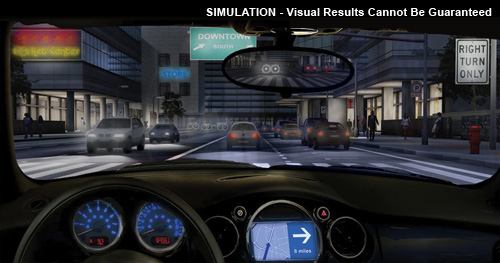TECNIS Multifocal Lens
Is your vision blurry or cloudy? Are you bothered by headlight glare when driving at night? If so, you may have cataracts. Consult your eye doctor to be sure. If you are exploring treatment options with your doctor, the TECNIS® Multifocal Implantable Lens may be the right choice for you.
It’s an advanced implantable lens, empowering you with high-quality vision in any light condition, from near to far distances—and everything in between. In fact, nearly 9 out of 10 patients don’t need glasses after the procedure.
Exceptional Full Range of Vision
Only the advanced TECNIS® Multifocal Lens enables you to see clearly at near, intermediate, and far distances without glasses in all light conditions.(1) Compare the following images. In the first image, which demonstrates vision with the TECNIS® Multifocal Lens, you can see the coffee cup close up, the dashboard at intermediate, as well as road signs in the distance—all clearly.

Now, compare the second image. This image demonstrates what you might see with a monofocal lens. Although the intermediate and distance vision is clear, notice how the coffee cup is now blurry.

Nighttime Driving
Immediately after surgery, some patients may notice rings around lights when driving at night. However, as the eye adjusts to the lens, the visual impression of rings may lessen or go away over time.

Am I a Candidate?
If you are diagnosed with cataracts and are experiencing one or more of the following symptoms, you may be a candidate for the TECNIS® Multifocal Lens:
- Difficulty reading
- Difficulty seeing close objects
- Difficulty seeing to drive, especially at night
- Changing glasses prescriptions
- Needing bifocals
Schedule an appointment to find out if the TECNIS® Multifocal Lens is an option that is right for your lifestyle and eye health.
Considerations with multifocal IOLs
- For many people, these IOL types reduce but do not eliminate the need for glasses or contact lenses. For example, a person can read without glasses, but the words appear less clear than with glasses.
- Each person’s success with these IOLs may depend on the size of his/her pupils and other eye health factors. People with astigmatism can ask their Eye M.D. about toric IOLs and related treatments.
- Side effects such as glare or halos around lights, or decreased sharpness of vision (contrast sensitivity) may occur, especially at night or in dim light. Most people adapt to and are not bothered by these effects, but those who frequently drive at night or need to focus on close-up work may be more satisfied with monofocal IOLs.
